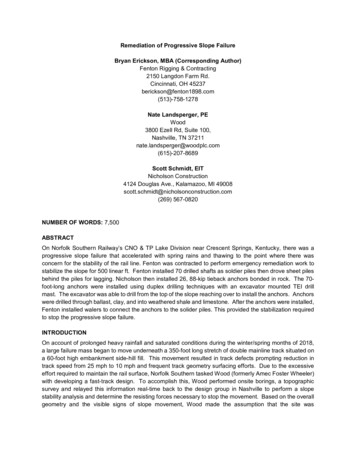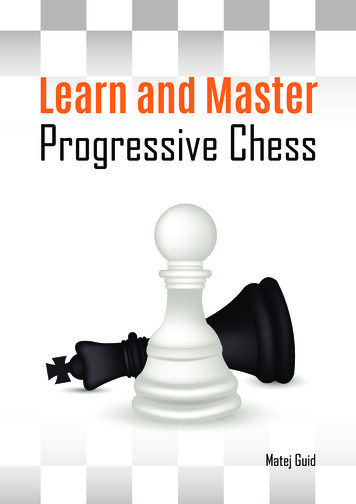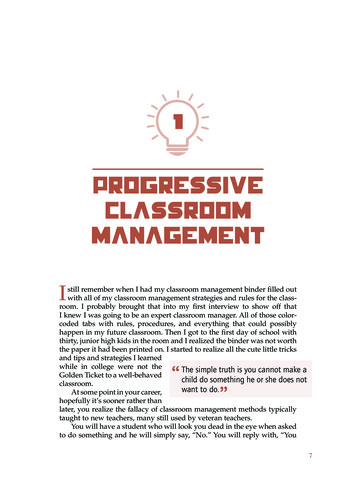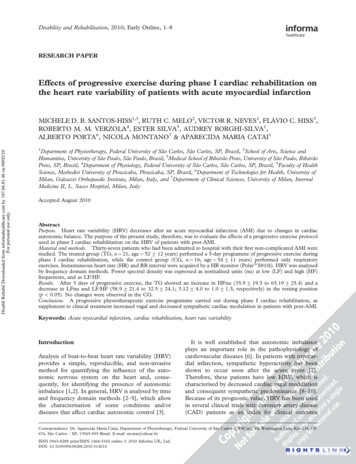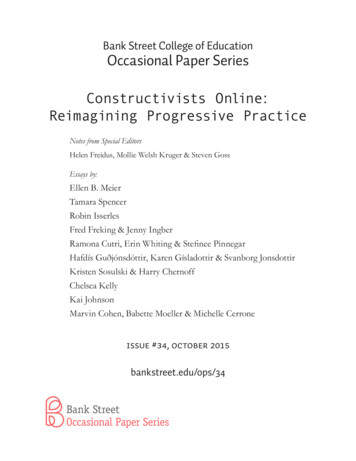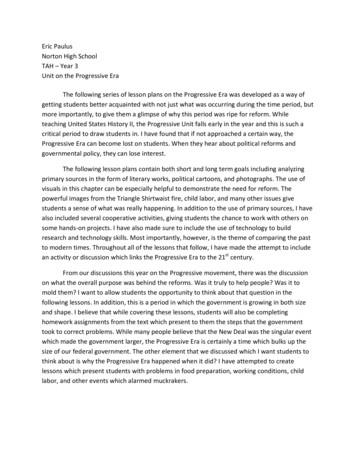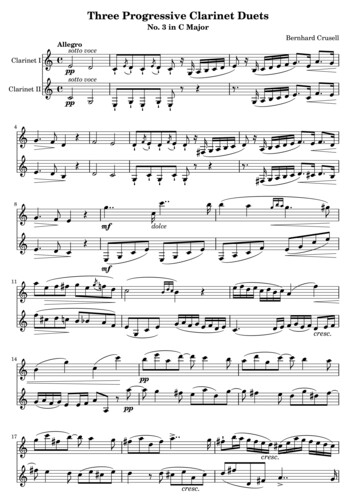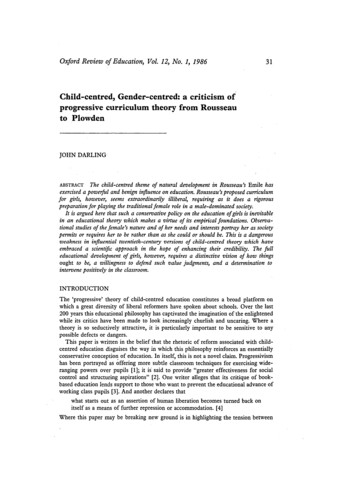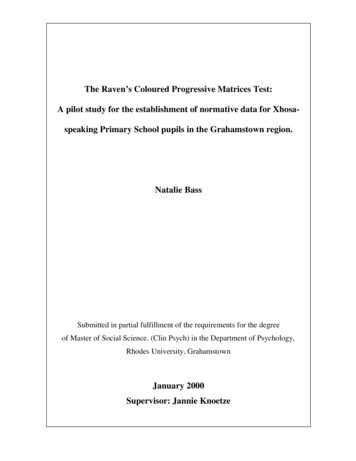
Transcription
The Raven’s Coloured Progressive Matrices Test:A pilot study for the establishment of normative data for Xhosaspeaking Primary School pupils in the Grahamstown region.Natalie BassSubmitted in partial fulfillment of the requirements for the degreeof Master of Social Science. (Clin Psych) in the Department of Psychology,Rhodes University, GrahamstownJanuary 2000Supervisor: Jannie Knoetze
AbstractThe Raven’s Coloured Progressive Matrices (CPM) test is used extensively across a widevariety of settings in South Africa, however more appropriate local normative data has yet tobe established. The CPM is internationally recognised as a culture-fair test of nonverbalintelligence, designed for use with children between the ages of 5½ and 11½. This pilotstudy thus sought to establish normative data for this instrument for a population of Xhosaspeaking Primary School children in the peri-urban township area in the Grahamstownregion. The booklet version of the test was used and it was administered in group format andaccording to an alternate method of test administration (using Xhosa instructions) developedby Vass in 1992. The final normative sample consisted of 197 male and 182 female Xhosaspeaking children in Grades Two to Seven (N 379).The results showed (1) a significant effect of age on test scores, where scores increased withage as expected; (2) a consistent tendency for males to outperform females was also noted,however small sample sizes precluded any categorical claims to this effect; (3) no significanteffect of education on test scores was observed and finally; (4) and finally, it appeared thatthe norms generated for this study revealed a tendency to be lower than those obtained byRaven, Court and Raven (1990) during the standardisation of this instrument in the UnitedKingdom and America. The study concluded that (1) there is an urgent need for moreappropriate South African normative data for this test; and (2) that when assessing Africanchildren from disadvantaged backgrounds, further research into the effects of cultural andsocio-economic factors and gender on non-verbal intelligence (and on performance on thistest in particular) is required.i
DeclarationThe author hereby declares that this whole thesis, unless specifically indicated to thecontrary in the text, is her own work.Natalie Bassii
AcknowledgementsJannie, thanks for being there, especially in the very beginning and at the end .I would also like to take this opportunity to thank the staff at the Department ofEducation for their cooperation and assistance on this project; and the children andstaff at the Primary school involved, for their enthusiastic participation and the use oftheir facilities.My deepest thanks also to Thabile Hlengane of the Grahamstown Education SupportCentre; for sharing her vast experience as a Remedial teacher working in schools inthis area with me, and for her extensive contributions as a test administrator, interpreterand field worker.In addition, this study would not have been possible without the funding supplied bythe C.S.D. (Centre for Scientific Development) as well as the generosity of the test’sdeveloper - Mr. John Raven who (when informed of the lack of availability of testbooklets in the Eastern Cape) offered 45 test booklets on loan. Your support isgratefully acknowledged.On a more personal note:-to Brendan – thanks especially for the very necessary post-M2 trip to Mozambique,where you and Dois-M made it all seem worthwhile .but more importantly,thank you for accompanying me on this journey for the past six years - you beingthere for me truly made all the difference.-to Renate – thanks for all the help, endless patience, your outstanding ability to‘work with large large documents’and for making the whole process of editing andprinting a master’s thesis virtually stress-free.-to my father, Stuart – thanks for everthing you’ve done to get me where I am today.-And finally, this thesis is dedicated to my late mother, Denise.iii
ontentsivIndex of TablesviChapter One1Introduction11.1 Overview11.2 Synopsis of the Current Study5Chapter Two6Cross-Cultural Ability Testing: The existing literature.62.1 Theoretical Approaches to Intelligence2.1.1 Psychometrically-based Theories2.1.2 Piagetian Theories2.1.3 Information-processing Theories2.1.4 The Theory of Multiple Intelligences2.2 The Assessment of Ability in Multicultural Settings2.2.1 Introduction2.2.2 Cross-cultural Psychology2.2.3 Cultural Bias in the Assessment of Ability2.2.4 Aptitude vs. Achievement Tests2.2.5 Methods of Establishing Cross-cultural Equivalence2.3. The Raven’s Coloured Progressive Matrices Test2.3.1 Introduction2.3.2 Validity2.3.3 Reliability2.3.4 The Application of the Raven’s in African society2.3.5 The Importance of this Study668911121213161920242426282933Chapter Three38Methodology383.1 Participants3.2. The Instrument3.2.1 Visual Aids3.2.2 The Translated Instructions3.3 Procedure3839394041iv
3.3.1 Data Collection3.3.2 Data Processing and Analysis4142Chapter Four44Results444.1 Description of the Sample454.2 Breakdown in terms of Age and Gender4.2.1 The Mean Ages of the Participants.4.3 The Scores on the Raven’s CPM: Normative Sample4.3.1 The Distribution of the Scores4.3.2. The Mean, Standard Deviation and Range of Scores4.4 Comparison of Scores across the Independent Variables4.4.1 Comparison of Scores Across Preschool & Failed Grades4.4.2 Comparison of Scores across Grades4.4.3 Comparison of Scores across Gender4.4.4 Comparison of Scores across Age4.5 The Norms4547494951515252555656Chapter Five58Discussion and Conclusion595.1 Discussion of Results5.1.1 The Effects of Age on Test Scores5.1.2 The Effect of Gender on Test Scores.5.1.3 The Effect of Grade on Test Scores5.1.4 The Effect of Failed Grades and Preschool Attendance on Test Scores5.2 The Norms5.2.1 Comparison of Norms with Raven et al. (1990).5.3 Limitations of the Study and Recommendations for Further Research59606162636364675.4 Conclusion69References70Appendix 176Appendix 277Appendix 378Appendix 479v
Index of TablesTable 1: Sample - by GRADE46Table 2: Sample - by AGE GROUPS48Table 3: t-Test results – Comparison of differences in Ages between theGenders49Table 4: Means, Standard Deviations, Range and Minimum and MaximumScores by GRADE53Table 5: t-test Results for the Comparison of scores across GENDER55Table 6: Mean Scores, Standard Deviation, Range, Minimum & MaximumScores by AGE57vi
Chapter OneIntroduction1.1 OverviewThe 1996 Bill of Rights declaration ‘Everyone has the right to a basic education’ hasled to an influx of previously ‘disadvantaged’ children into classrooms across SouthAfrica, resulting in pupil-teacher ratios as high as 49:1 (Shindler, 1997). Recentrevisions in state Education policy have led to the introduction of a new curriculumprogramme – Curriculum 2005, specially designed to meet the changing needs of ourmulticultural society. In addition to their contributions in the planning and evaluationof the new programme (Foxcroft, 1996), clinical psychologists are also depended uponfor the fair and accurate cross-cultural psychometric assessment and placement ofchildren within it. The ensuing increase in referrals from teachers and parents toclinical psychologists working in community outpatient settings throughout SouthAfrica, must therefore be seen to be exerting considerable pressure on already overtaxed resources.In a comprehensive review of contemporary concerns in mainstream South Africancross-cultural assessment, Retief (1988) concluded that despite its historically racistorigins, considerable progress has been made in eradicating regional iceoffaircross-culturalpsychometric assessment. A review of the international literature revealed the mostimportant obstacles identified as playing a role in any form of cross-culturalassessment to be: (1) language and translation (Bracken and Barona, 1991; Reddy,Knowles & Reddy, 1995); (2) a lack of familiarity with the testing situation and1
process (Lonner, 1990; Merenda, 1994); (3) content, method and item cultural bias(Poortinga, 1995; Van de Vijver & Poortinga, 1995); and finally (4) a shortage ofappropriate normative data (Geisinger, 1994; Helms-Lorenz & Van de Vijver, 1995).In a ‘blueprint for relevant assessment practices in South Africa’, Foxcroft (1996)asserts:“[t]hat a larger storehouse of appropriate measures for use in SouthAfrica should be created by developing culture-reduced tests withappropriate norms for diverse groups of children and adolescents in ourcountry; andadapting and norming useful tests that have beendeveloped overseas” (p. 12 –13).She argues further that the range of the term assessment should be broadened toinclude appropriately normed screening measures that could be used effectively in thetesting of large groups of children. It is asserted that this approach will facilitate themore effective channeling of pupils through the new school curriculum, through:“[t]he early identification of those children requiring an in-depthdiagnostic assessment to verify developmental delays and plan forremedial intervention, those requiring further monitoring and possiblerescreening in the future, and finally, those requiring no furtherevaluation” (p. 7).Although developed and normed on British and American populations, the Raven’sColoured Progressive Matrices test (CPM) is internationally recognised as a culturefair test of non-verbal intelligence for young children (Raven, Court and Raven,1990). It is important to note however, that the test cannot be employed to assessgeneral intelligence, unless used in conjunction with an equally reliable and valid testof verbal intelligence (Raven et al., 1990). This easily administered, pencil and paper2
test has no time limit and comprises three sets of twelve problems, arranged to “assessmental development up to a stage when a person is sufficiently able to reason byanalogy to adopt this way of thinking as a consistent method of inference” (Raven etal., 1990, p. CPM2).The test’s innovative design thus effectively minimises and/or eliminates the fourmajor cultural and educational obstacles to the construction of culture-reduced testsidentified by Anastasi and Urbania (1997); namely language, test content, reading andspeed.The Raven’s CPM has been used effectively in a wide variety of cross-cultural settings for children between the ages of 5 and 11; and normative data hasbeen successfully established for among others – Inuit children in Arctic Quebec(Wright, Taylor and Ruggiero, 1996); children in rural India (Barnabas, Kapur & Rao,1995); and Polish children (Jaworska & Szustrowa, 1993). Although used extensivelyacross a wide variety of settings in South Africa, there are currently no availableSouth African norms for this test. This pilot study therefore seeks to make a positivecontribution to the effective channeling of Xhosa-speaking primary school children inthe peri-urban ‘township’ settings in the Grahamstown region, by developing muchneeded local normative data.In a similar endeavor, Vass (1992) established normative data for the Raven’sStandard Progressive Matrices Test (the version for individuals older than 11 yearsand 6 months) for a representative sample of Xhosa-speaking Secondary Schoolpupils in the Grahamstown region. In addition, he also investigated the effect of testpresentation on test results by employing two different methods of test presentationfor his normative and alternate samples.Respondents in the smaller (alternate)3
sample were administered the test using the original instructions translated intoXhosa, and two sets of visual aids (wherein the Record form and Item 1 of the testwere reproduced double the size of the original as stipulated by Raven et al., 1990).In contrast, those in the normative sample were given the same set of instructionsexcept that they had been extended to cover Item 2; and were presented with threesets of visual aids three times the size of the originals, where the six possible answersfor each of the two test items were represented in the form of movable parts. Thelatter modification of method of test presentation allowed respondents to participatemore actively during the ‘instructional phase’ of the test’s administration (Vass,1992).His results showed that (1) the norms generated for the normative sample wereconsiderably lower than previously established norms in similar studies conductedoverseas; (2) that pupils in the normative sample scored significantly higher thanthose in the alternate sample (indicating that method of presentation on the Raven’sSPM is important when assessing pupils that may be regarded as disadvantaged); (3)that male respondents scored significantly higher than female respondents; andfinally, (4) that there was a significant effect of age, educational level and gender ontest scores.Thus to conclude, the primary objective of this study is to establish norms for theRaven’s CPM test for Xhosa-speaking Primary School pupils in the Grahamstownregion.Secondly, the results obtained will be compared with normative dataestablished for this test in Western Populations; and examined across the different age4
groups, genders and grades in order to identify the possible effects of these variableson test scores.1.2 Synopsis of the Current StudyChapter Two reviews the literature in the following areas: firstly, the varioustheoretical traditions that have been developed and adopted in the study of humanintelligence; secondly, the practice of ability testing in multicultural societies, and theproblems associated with this process; and finally, the administration of the Raven’sCPM in multi-cultural settings including the limited South African literature.Chapter Three begins with an overview of the methodology adopted in this study. Inaddition, the sampling procedures, method of test administr
The Raven’s Coloured Progressive Matrices Test: A pilot study for the establishment of normative data for Xhosa-speaking Primary School pupils in the Grahamstown region. Natalie Bass Submitted in partial fulfillment of the require ments for the degree of Master of Social Science. (Clin Psych) in the Department of Psychology, Rhodes University, Grahamstown January 2000 Supervisor: Jannie .
